 Technology peripherals
Technology peripherals
 AI
AI
 AI dimensionality reduction attacks human painters, Vincentian graphs are introduced into ControlNet, and depth and edge information are fully reusable
AI dimensionality reduction attacks human painters, Vincentian graphs are introduced into ControlNet, and depth and edge information are fully reusable
AI dimensionality reduction attacks human painters, Vincentian graphs are introduced into ControlNet, and depth and edge information are fully reusable
With the emergence of large text-image models, generating an attractive image has become very simple. All the user needs to do is to enter a simple prompt with the movement of their fingers. After obtaining the image through a series of operations, we will inevitably have several questions: Can the image generated based on prompt meet our requirements? What kind of architecture should we build to handle the various requirements raised by users? Can large models still maintain the advantages and capabilities gained from billions of images in specific tasks?
In order to answer these questions, researchers from Stanford conducted a large number of investigations on various image processing applications and came to the following three findings:
First of all, the available data in a specific field is actually less than the data for training general models. This is mainly reflected in the fact that for example, the largest data set on a specific problem (such as gesture understanding, etc.) is usually less than 100k, which is smaller than large-scale, The multimodal text image dataset LAION 5B is 5 × 10^4 orders of magnitude smaller. This requires the neural network to be robust to avoid model overfitting and to have good generalization when targeting specific problems.
Secondly, when using data-driven processing of image tasks, large computing clusters are not always available. This is where fast training methods become important, methods that can optimize large models for specific tasks within acceptable time and memory space. Furthermore, fine-tuning, transfer learning and other operations may be required in subsequent processing.
Finally, various problems encountered in the image processing process will have different forms of definition. When solving these problems, although the image diffusion algorithm can be adjusted in a "procedural" way, for example, constraining the denoising process, editing multi-head attention activation, etc., these hand-crafted rules are basically dictated by human instructions ,Considering some specific tasks such as depth-image, pose-person, etc., these problems essentially require the interpretation of raw inputs into object-level or scene-level understanding, which makes hand-crafted procedural approaches less feasible. Therefore, to provide solutions in multiple tasks, end-to-end learning is essential.
Based on the above findings, this paper proposes an end-to-end neural network architecture ControlNet, which can control the diffusion model (such as Stable Diffusion) by adding additional conditions, thereby improving the graph. Picture effect, and can generate full-color pictures from line drawings, generate pictures with the same depth structure, and optimize the generation of hands through key points of the hands.
Paper address: https://arxiv.org/pdf/2302.05543.pdf
Project Address: https://github.com/lllyasviel/ControlNet
Effect display
So what is the effect of ControlNet?
Canny Edge Detection: By extracting line drawing from the original image, an image of the same composition can be generated.
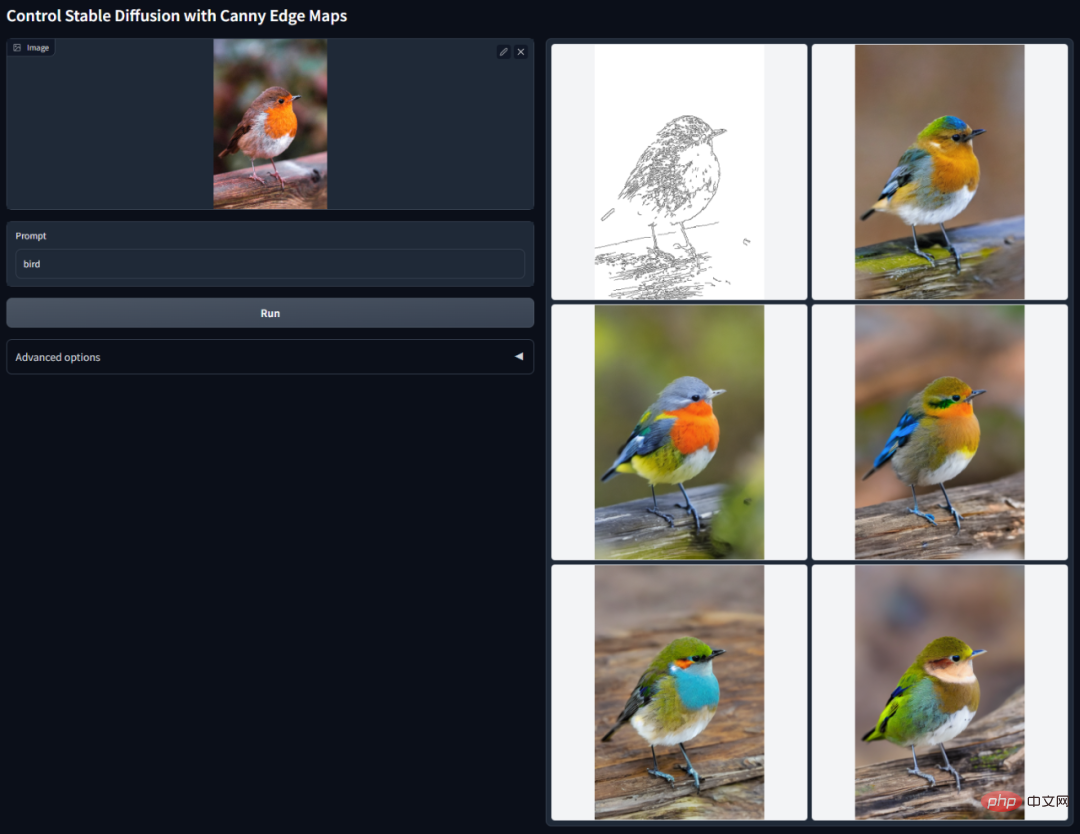
Depth detection: By extracting the depth information in the original image, a map with the same depth structure can be generated.

ControlNet with semantic segmentation:
Using learning-based The deep Hough transform detects straight lines from Places2 and then uses BLIP to generate subtitles.
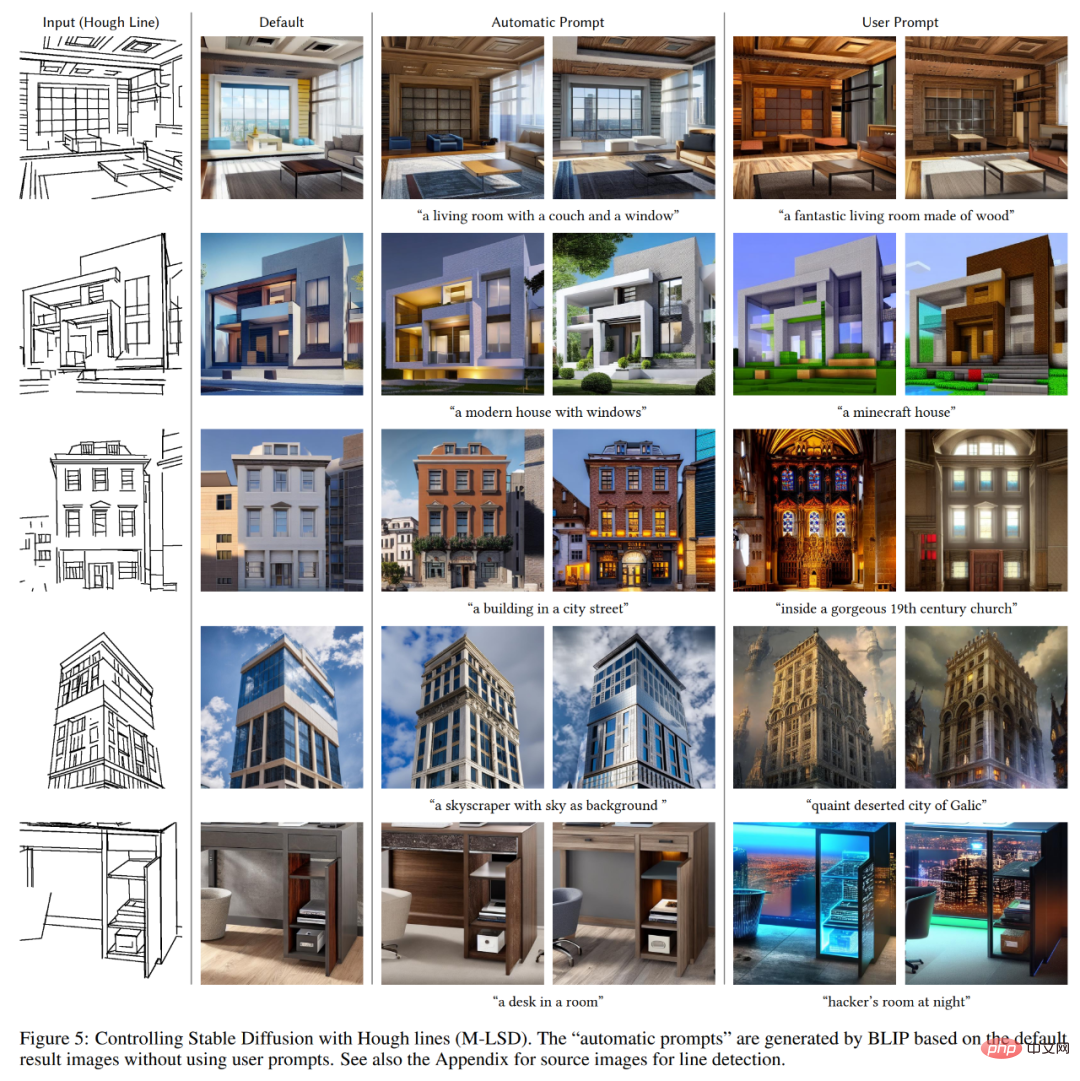
HED edge detection illustration.
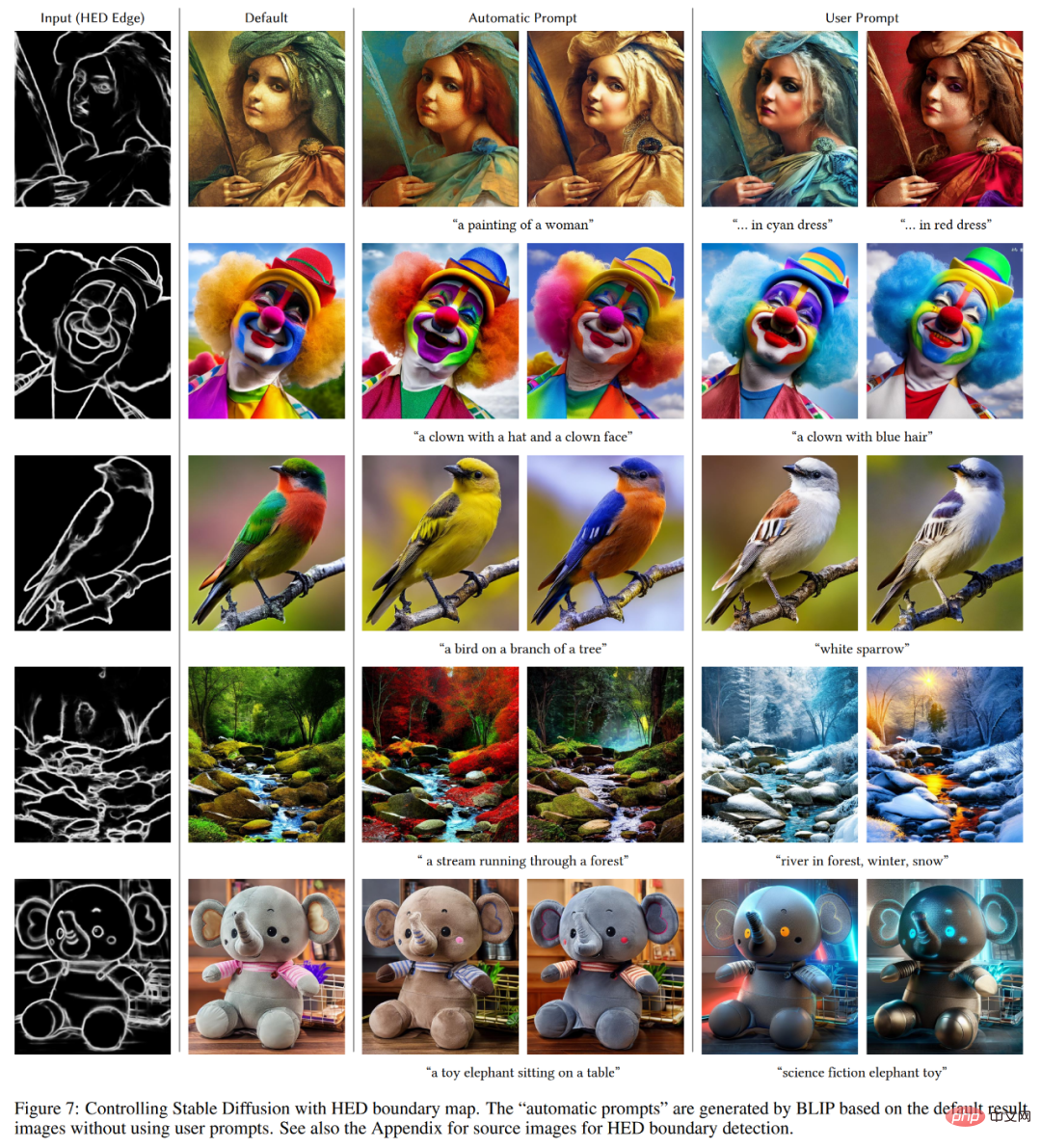
Illustration of human posture recognition.
Method Introduction
ControlNet is a neural network architecture that enhances pre-trained image diffusion models with task-specific conditions. Let's first look at the basic structure of ControlNet.
ControlNet manipulates the input conditions of neural network blocks, thereby further controlling the overall behavior of the entire neural network. Here "network block" refers to a group of neural layers that are put together as a common unit for building neural networks, such as resnet block, multi-head attention block, and Transformer block.
Taking 2D features as an example, given a feature map x ϵ R^h×w×c, where {h, w, c} are the height, width and number of channels respectively. A neural network block F (・; Θ) with a set of parameters Θ transforms x into another feature map y as shown in equation (1) below.

This process is shown in Figure 2-(a) below.

Neural network blocks are connected by a unique convolution layer called "zero convolution", which is the weight 1×1 convolutional layer with zero initialization and bias. The researcher represents the zero convolution operation as Z (・;・) and uses two parameter instances {Θ_z1, Θ_z2} to form the ControlNet structure, as shown in the following formula (2).
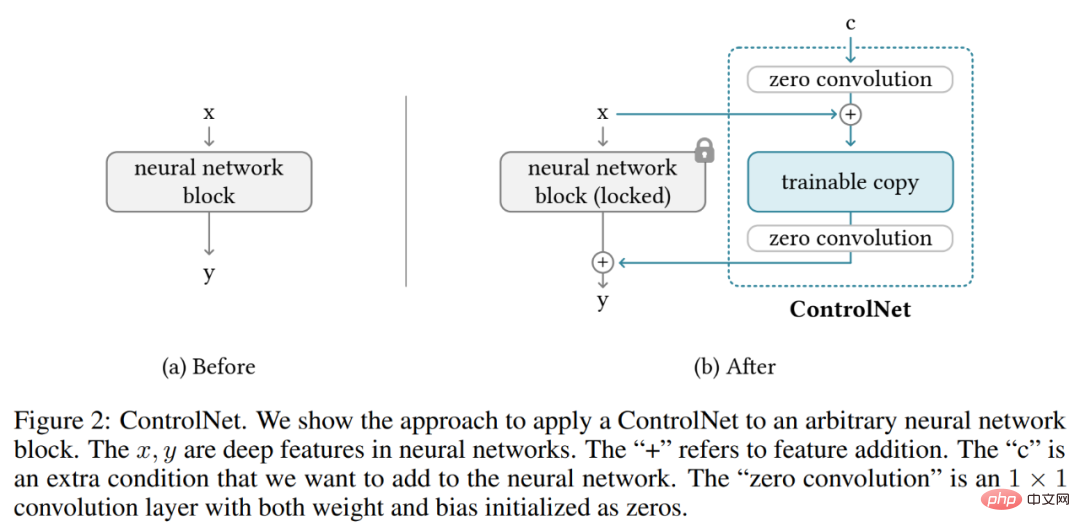
where y_c becomes the output of the neural network block, as shown in Figure 2-(b) below.
ControlNet in image diffusion model
##The researcher took Stable Diffusion as an example to introduce how to use ControlNet control Large-scale diffusion models with task-specific conditions. Stable Diffusion is a large-scale text-to-image diffusion model trained on billions of images, essentially a U-net consisting of an encoder, intermediate blocks, and a residual-connected decoder.
As shown in Figure 3 below, the researcher uses ControlNet to control each layer of U-net. Note that the way ControlNet is connected here is computationally efficient: since the original weights are locked, the gradient calculation on the original encoder does not require training. And because half of the gradient calculations on the original model are reduced, training can be accelerated and GPU memory can be saved. Training a Stable Diffusion model using ControlNet only requires approximately 23% more GPU memory and 34% more time per training iteration (tested on a single Nvidia A100 PCIE 40G).
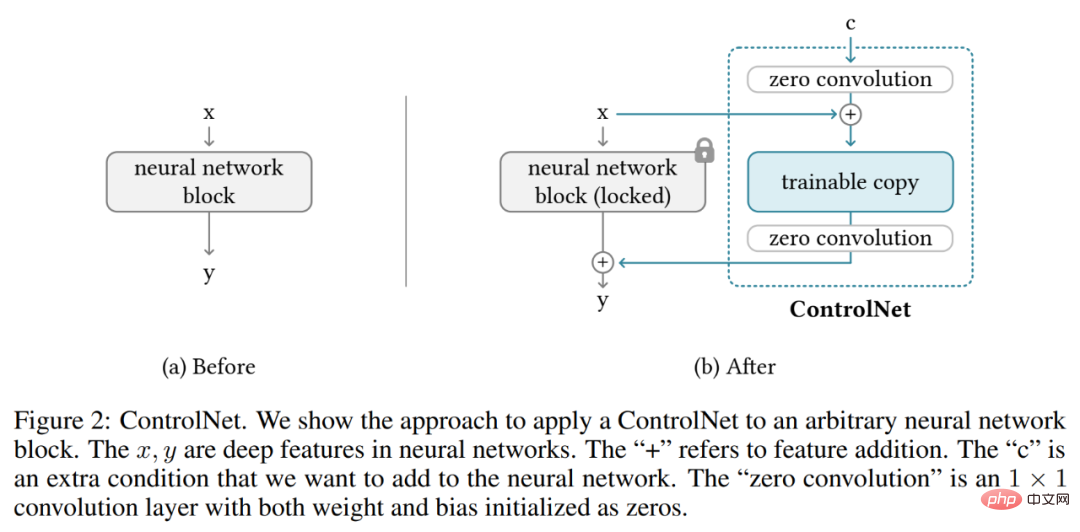
#Specifically, the researchers used ControlNet to create 12 encoding blocks and 1 Stable Diffusion intermediate block that are trainable copy. The 12 coding blocks come in 4 resolutions, 64×64, 32×32, 16×16, and 8×8, with 3 blocks in each resolution. The output is added to the U-net with 12 residual connections and 1 intermediate block. Since Stable Diffusion is a typical U-net structure, it is likely that this ControlNet architecture can be used in other diffusion models.
Training and Boosting Training
Given an image z_0, the diffusion algorithm progressively adds noise to the image and generates noise Image z_t, t is the number of times noise is added. When t is large enough, the image approximates pure noise. Given a set of conditions including time step t, text prompts c_t, and task-specific conditions c_f, the image diffusion algorithm learns a network ϵ_θ to predict the noise added to a noisy image z_t, as shown in Equation (10) below.

During the training process, the researchers randomly replaced 50% of the text prompts c_t with empty strings, which is beneficial to ControlNet's ability to identify semantic content from the input condition map.
In addition, the researchers also discussed several strategies to improve the training of ControlNets, especially when computing devices are very limited (such as laptops) or very powerful (such as with large-scale GPUs available). computing cluster).
Please refer to the original paper for more technical details.
The above is the detailed content of AI dimensionality reduction attacks human painters, Vincentian graphs are introduced into ControlNet, and depth and edge information are fully reusable. For more information, please follow other related articles on the PHP Chinese website!

Hot AI Tools

Undresser.AI Undress
AI-powered app for creating realistic nude photos

AI Clothes Remover
Online AI tool for removing clothes from photos.

Undress AI Tool
Undress images for free

Clothoff.io
AI clothes remover

AI Hentai Generator
Generate AI Hentai for free.

Hot Article

Hot Tools

Notepad++7.3.1
Easy-to-use and free code editor

SublimeText3 Chinese version
Chinese version, very easy to use

Zend Studio 13.0.1
Powerful PHP integrated development environment

Dreamweaver CS6
Visual web development tools

SublimeText3 Mac version
God-level code editing software (SublimeText3)

Hot Topics
 1377
1377
 52
52
 The world's most powerful open source MoE model is here, with Chinese capabilities comparable to GPT-4, and the price is only nearly one percent of GPT-4-Turbo
May 07, 2024 pm 04:13 PM
The world's most powerful open source MoE model is here, with Chinese capabilities comparable to GPT-4, and the price is only nearly one percent of GPT-4-Turbo
May 07, 2024 pm 04:13 PM
Imagine an artificial intelligence model that not only has the ability to surpass traditional computing, but also achieves more efficient performance at a lower cost. This is not science fiction, DeepSeek-V2[1], the world’s most powerful open source MoE model is here. DeepSeek-V2 is a powerful mixture of experts (MoE) language model with the characteristics of economical training and efficient inference. It consists of 236B parameters, 21B of which are used to activate each marker. Compared with DeepSeek67B, DeepSeek-V2 has stronger performance, while saving 42.5% of training costs, reducing KV cache by 93.3%, and increasing the maximum generation throughput to 5.76 times. DeepSeek is a company exploring general artificial intelligence
 AI subverts mathematical research! Fields Medal winner and Chinese-American mathematician led 11 top-ranked papers | Liked by Terence Tao
Apr 09, 2024 am 11:52 AM
AI subverts mathematical research! Fields Medal winner and Chinese-American mathematician led 11 top-ranked papers | Liked by Terence Tao
Apr 09, 2024 am 11:52 AM
AI is indeed changing mathematics. Recently, Tao Zhexuan, who has been paying close attention to this issue, forwarded the latest issue of "Bulletin of the American Mathematical Society" (Bulletin of the American Mathematical Society). Focusing on the topic "Will machines change mathematics?", many mathematicians expressed their opinions. The whole process was full of sparks, hardcore and exciting. The author has a strong lineup, including Fields Medal winner Akshay Venkatesh, Chinese mathematician Zheng Lejun, NYU computer scientist Ernest Davis and many other well-known scholars in the industry. The world of AI has changed dramatically. You know, many of these articles were submitted a year ago.
 Hello, electric Atlas! Boston Dynamics robot comes back to life, 180-degree weird moves scare Musk
Apr 18, 2024 pm 07:58 PM
Hello, electric Atlas! Boston Dynamics robot comes back to life, 180-degree weird moves scare Musk
Apr 18, 2024 pm 07:58 PM
Boston Dynamics Atlas officially enters the era of electric robots! Yesterday, the hydraulic Atlas just "tearfully" withdrew from the stage of history. Today, Boston Dynamics announced that the electric Atlas is on the job. It seems that in the field of commercial humanoid robots, Boston Dynamics is determined to compete with Tesla. After the new video was released, it had already been viewed by more than one million people in just ten hours. The old people leave and new roles appear. This is a historical necessity. There is no doubt that this year is the explosive year of humanoid robots. Netizens commented: The advancement of robots has made this year's opening ceremony look like a human, and the degree of freedom is far greater than that of humans. But is this really not a horror movie? At the beginning of the video, Atlas is lying calmly on the ground, seemingly on his back. What follows is jaw-dropping
 KAN, which replaces MLP, has been extended to convolution by open source projects
Jun 01, 2024 pm 10:03 PM
KAN, which replaces MLP, has been extended to convolution by open source projects
Jun 01, 2024 pm 10:03 PM
Earlier this month, researchers from MIT and other institutions proposed a very promising alternative to MLP - KAN. KAN outperforms MLP in terms of accuracy and interpretability. And it can outperform MLP running with a larger number of parameters with a very small number of parameters. For example, the authors stated that they used KAN to reproduce DeepMind's results with a smaller network and a higher degree of automation. Specifically, DeepMind's MLP has about 300,000 parameters, while KAN only has about 200 parameters. KAN has a strong mathematical foundation like MLP. MLP is based on the universal approximation theorem, while KAN is based on the Kolmogorov-Arnold representation theorem. As shown in the figure below, KAN has
 Google is ecstatic: JAX performance surpasses Pytorch and TensorFlow! It may become the fastest choice for GPU inference training
Apr 01, 2024 pm 07:46 PM
Google is ecstatic: JAX performance surpasses Pytorch and TensorFlow! It may become the fastest choice for GPU inference training
Apr 01, 2024 pm 07:46 PM
The performance of JAX, promoted by Google, has surpassed that of Pytorch and TensorFlow in recent benchmark tests, ranking first in 7 indicators. And the test was not done on the TPU with the best JAX performance. Although among developers, Pytorch is still more popular than Tensorflow. But in the future, perhaps more large models will be trained and run based on the JAX platform. Models Recently, the Keras team benchmarked three backends (TensorFlow, JAX, PyTorch) with the native PyTorch implementation and Keras2 with TensorFlow. First, they select a set of mainstream
 Tesla robots work in factories, Musk: The degree of freedom of hands will reach 22 this year!
May 06, 2024 pm 04:13 PM
Tesla robots work in factories, Musk: The degree of freedom of hands will reach 22 this year!
May 06, 2024 pm 04:13 PM
The latest video of Tesla's robot Optimus is released, and it can already work in the factory. At normal speed, it sorts batteries (Tesla's 4680 batteries) like this: The official also released what it looks like at 20x speed - on a small "workstation", picking and picking and picking: This time it is released One of the highlights of the video is that Optimus completes this work in the factory, completely autonomously, without human intervention throughout the process. And from the perspective of Optimus, it can also pick up and place the crooked battery, focusing on automatic error correction: Regarding Optimus's hand, NVIDIA scientist Jim Fan gave a high evaluation: Optimus's hand is the world's five-fingered robot. One of the most dexterous. Its hands are not only tactile
 FisheyeDetNet: the first target detection algorithm based on fisheye camera
Apr 26, 2024 am 11:37 AM
FisheyeDetNet: the first target detection algorithm based on fisheye camera
Apr 26, 2024 am 11:37 AM
Target detection is a relatively mature problem in autonomous driving systems, among which pedestrian detection is one of the earliest algorithms to be deployed. Very comprehensive research has been carried out in most papers. However, distance perception using fisheye cameras for surround view is relatively less studied. Due to large radial distortion, standard bounding box representation is difficult to implement in fisheye cameras. To alleviate the above description, we explore extended bounding box, ellipse, and general polygon designs into polar/angular representations and define an instance segmentation mIOU metric to analyze these representations. The proposed model fisheyeDetNet with polygonal shape outperforms other models and simultaneously achieves 49.5% mAP on the Valeo fisheye camera dataset for autonomous driving
 DualBEV: significantly surpassing BEVFormer and BEVDet4D, open the book!
Mar 21, 2024 pm 05:21 PM
DualBEV: significantly surpassing BEVFormer and BEVDet4D, open the book!
Mar 21, 2024 pm 05:21 PM
This paper explores the problem of accurately detecting objects from different viewing angles (such as perspective and bird's-eye view) in autonomous driving, especially how to effectively transform features from perspective (PV) to bird's-eye view (BEV) space. Transformation is implemented via the Visual Transformation (VT) module. Existing methods are broadly divided into two strategies: 2D to 3D and 3D to 2D conversion. 2D-to-3D methods improve dense 2D features by predicting depth probabilities, but the inherent uncertainty of depth predictions, especially in distant regions, may introduce inaccuracies. While 3D to 2D methods usually use 3D queries to sample 2D features and learn the attention weights of the correspondence between 3D and 2D features through a Transformer, which increases the computational and deployment time.



